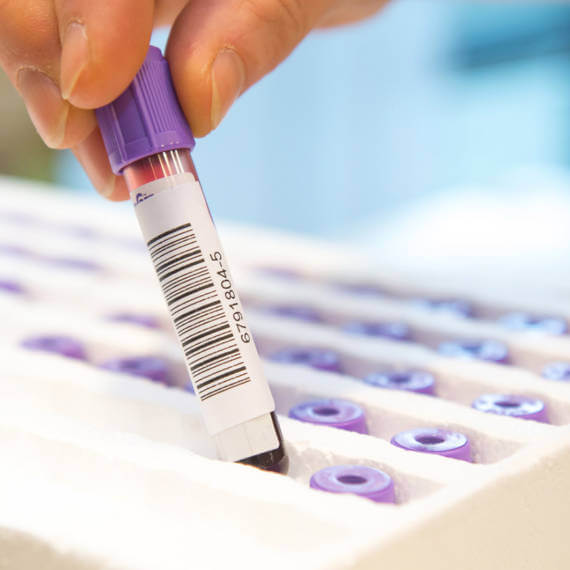Ovarian reserve testing, FSH test, AMH test
Ovarian reserve is a popular measure of the reproductive potential of the ovary. Low ovarian reserve does not imply that pregnancy is impossible. It provides information that:
- The time to get pregnant is probably very limited.
- The probability of getting pregnant is reduced.
- Abandoning low-effectiveness treatment methods (observation of the cycle, stimulation of ovulation and attempts at getting pregnant naturally or intrauterine insemination) should be seriously considered.
- The response of the ovaries to drug-induced stimulation may be abnormally low and as a consequence, increased doses of the medicines may be required.
What reduces the ovarian reserve and how can it be improved?
- The most important factor is age. After approximately 20 years of age, the ovarian reserve starts decreasing. For the next 10 years, this process is quite slow in most women. Later, the dynamics of change increase significantly, to reach the highest reduction in women over 35 years of age. It should be emphasised that the rate of reduction of the ovarian reserve is a highly individual matter, unrelated to the external signs of ageing.
- Smoking cigarettes is the best know factor decreasing the ovarian reserve that a woman can control.
- Ovarian cysts and associated surgeries. For maintaining a normal ovarian reserve, both proper qualification for the procedure and the choice of the surgical technique are very important.
Functional ovarian cysts and other cysts
- A majority of ovarian cysts are so-called functional cysts, and they should be monitored or treated conservatively (usually they disappear spontaneously, or after administration of contraceptives).
- Other cysts that require surgical treatment should be removed after a careful consideration of all the pros and cons. The cyst itself, as well as the surgical procedure, adversely affect the ovarian reserve.
- According to the present state of knowledge, improving the ovarian reserve is not possible. In very rare cases a clinically insignificant improvement of selected parameters describing the reserve may be observed. Unfortunately, the change is usually a result of standard measurement errors.
Presently, the best methods for the assessment of the ovarian reserve include:
Antral follicle count (AFC)
Ovary with follicles
Antral follicles are follicles of 2-8 mm, located in the ovaries, whose growth is stimulated by natural pituitary gonadotropins, or by the same hormones administered in the course of treatment. During their growth, antral follicles become dominant follicles, in which oocytes mature.
The AFC assessment can be performed during the initial evaluation of the ovaries, already at the first visit at the doctor’s office. The most reliable scientific studies revealed that the AFC below four follicles per ovary is associated with a considerably reduced chances of pregnancy and with abnormal ovarian response to stimulation of ovulation.
Serum AMH (Anti-Mullerian Hormone) concentration
Serum AMH (Anti-Mullerian Hormone) concentration
AMH hormone – AMH tests
Low AMH concentrations indicate a reduced ovarian reserve, whereas high levels may be predictive of the ovarian hyperstimulation syndrome.
AMH assay is presently a standard method for the ovarian reserve assessment. Results below 0.7-1.0 ng/l indicate a low reserve.
Low AMH and pregnancy
Please remember that a single low AMH result does not eliminate the chances of getting pregnant, especially in young women.
We are often asked: if my AMH is very low, will I start menopause in a few or several months?
Presently, we have no evidence-based data supporting that correlation.
It is important to remember a few facts about AMH:
- Women with extremely low AMH can menstruate regularly (so they are not menopausal).
- A single AMH result, even below the normal range, provides a detailed information about the ovarian reserve, but only for the given moment. We do not know is AMH was low before. We do not know the dynamics of change regarding the ovarian reserve in the next years. AMH might have been low previously, and the woman can have a low AMH level throughout her life, until the menopause at approximately 50 years of age, but she can also have children.
Serum FSH (Follicular Stimulating Hormone) concentration on the 2nd or 3rd day of the cycle
FSH normal range – FSH tests
Increased FSH concentration adversely affects:
- normal ovarian response to stimulation,
- normal oocyte count,
- chances of getting pregnant (especially with high concentrations).
Unfortunately, unambiguous determination of the threshold value is difficult. Concentrations over 10 IU/l indicate a reduced ovarian reserve. Quite often, we see normal FSH results in women with a low ovarian reserve. Therefore, presently, FSH tests in the assessment of the ovarian reserve should always be accompanied by AFC and AMH concentration assay.
What FSH concentrations should be considered abnormal in women who wish to get pregnant?
Women with high FSH concentration may menstruate regularly, and have individual ovulation cycles. However, when evaluating the ovarian reserve in women who wish to get pregnant, FSH concentration above 10 mIU/ml is an alarming result. FSH levels above 15 mIU/ml are generally considered abnormal, whereas with FSH > 25 mIU/ml, the chances of getting pregnant are very slim.
When evaluating tests results, it is important to remember that FSH concentrations may differ between cycles.
